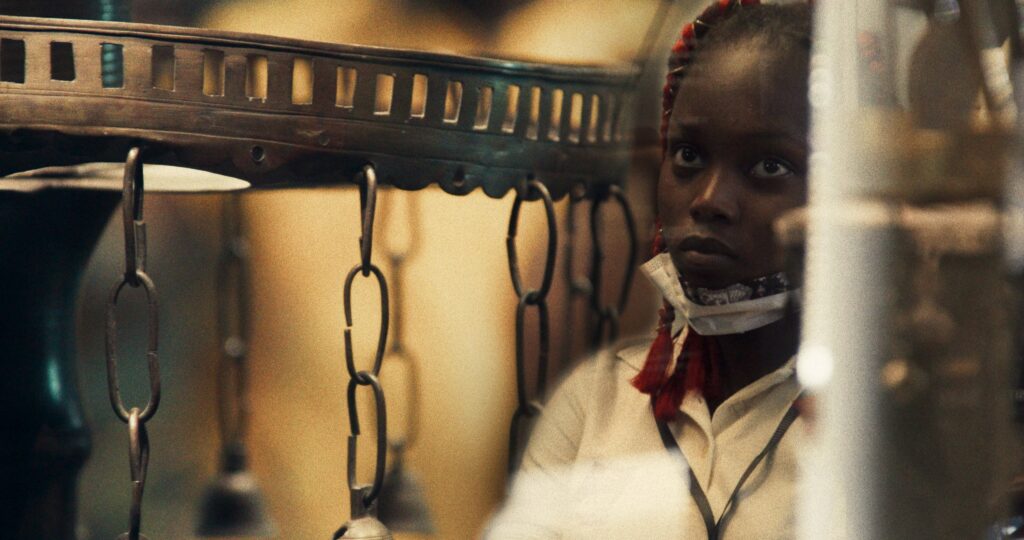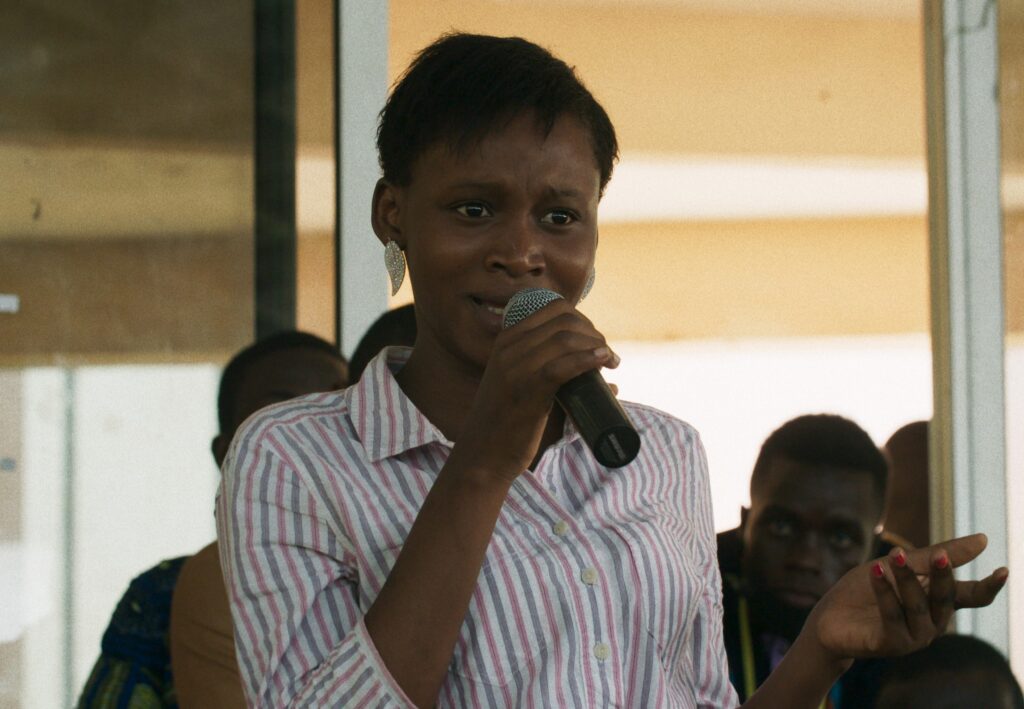Blending reality with elements of fantasy, Mati Diop’s sophomore feature film DAHOMEY grapples with the real-life narrative of the repatriation of 26 royal artifacts from France back to the Republic of Benin. A profound reflection on themes of cultural identity, colonialism, and restitution, Diop’s innovative storytelling provides a voice to the inanimate, inviting audiences to consider the deep impacts of historical looting and the complexities of reconciling with a past that shapes our present and future.
What sets DAHOMEY apart is its narrative articulated through the imaginative perspective of “artifact #26,” a statue, and for all intents and purposes, the film’s protagonist. Each artifact’s return, marked by a numerical label, symbolizes a broader issue of displacement and fragmentation. The anthropomorphization of #26, represented by an otherworldly, ghostly voiceover, serves as a critical narrative device that elevates the film beyond traditional documentary boundaries.
Through #26’s eyes, the audience is offered a unique vantage point on history, one that is both intimate and grand.
This approach humanizes the broader story of restitution. The artifact’s reflections on its origins in the Kingdom of Dahomey, its time in a French museum, and its eventual return to a modern Benin that has evolved in its absence, encapsulates the emotional and spiritual dimensions of repatriation.
The film begins with the historical context of the Kingdom of Dahomey, a powerful state whose cultural vibrancy was violently disrupted when French colonial troops looted its treasures in 1892.
Diop allocates a healthy portion of the film’s first act to the meticulous care taken by the French in transporting these artifacts—stripped from their sacred contexts and relegated to mere display items in a French museum—back to Benin. This starkly contrasts with the brutal history of colonial exploitation and dehumanization. It’s a disparity that immediately raises questions about value, respect, and humanity—what and who are deemed worthy of care and recognition.

Diop does not shy away from the complexities of the restitution process, illustrating both the logistical challenges and the emotional impact of reintegrating these artifacts into Benin’s cultural landscape. It’s a transition that avoids a reductive portrayal of return as a triumphant closure.
Instead, Diop presents it as the beginning of a new chapter of reconciliation and understanding as the artifact’s return prompts a national introspection in Benin.
Number 26’s voiceover speaks to the historical injustices of colonialism, not just through the act of plundering but through the ongoing impact on identity and heritage. It questions the motives behind its repatriation, pondering whether this act is one of genuine restitution or a performative gesture by the former colonizers.
The ghostly narration asks poignant questions about what it means to once be an integral part of a cultural context and now return to a society that may no longer remember its significance.
The statue’s perspective also invites the audience to consider ethical and philosophical questions about the nature of artifacts, their role as carriers of history and culture, and the responsibilities of both the colonizers and the colonized in preserving and honoring this heritage.
This dialogue between history and modernity is a recurring theme, explored through the perspectives of various stakeholders, including students, historians, and cultural experts, reflecting the multifaceted implications at hand.
The heart of the film unfolds through a series of debates among students at the University of Abomey-Calavi in Benin, where the implications of the artifacts’ return are passionately discussed. These debates serve as a microcosm of the national conversation in Benin, reflecting a spectrum of opinions.
Through these discussions, Diop captures the generational divides and hopes that surface, presenting the youth of Benin as key protagonists in the unfolding narrative of restitution.
DAHOMEY also engages with the aesthetics of storytelling, employing sound elements and visual techniques to enhance the narrative’s emotional depth. Diop’s background in sound is evident in the careful crafting of #26’s hauntingly ethereal voice that emerges from sound design that blends historical authenticity with a sense of the mystical.

This combined with the film’s visual language, employing a careful composition of shots that capture both the tangible journey of the artifacts and their intangible cultural significance, creates a sensory experience that complements the thematic explorations.
Comparing DAHOMEY with Diop’s earlier work, notably, ATLANTICS, reveals a consistent focus on loss, belonging, and the unseen forces that shape human experiences. Yet, DAHOMEY pushes further.
It can also be seen as an imaginative extension and critique of the themes presented in STATUES ALSO DIE (1953) by Chris Marker, Alain Resnais, and Ghislain Cloquet. While the latter focuses on how African artifacts lose their cultural and spiritual significance when displayed in Western museums, stripped of their original contexts, DAHOMEY explores the potential for these artifacts to regain their “life” through the process of repatriation and recontextualization within their indigenous culture.
DAHOMEY offers a hopeful narrative about the possibility of revival and the enduring resilience of artifacts and the communities they represent, moving beyond critique to envision a path toward healing and reconciliation.
In crafting DAHOMEY, Diop has not only created a film but a multifaceted dialogue on the power of cultural artifacts to bridge past and present, to heal, and to provoke thought. The choice to center this dialogue around artifact #26 offers a compelling lens through which to view the narrative of repatriation as one that is as much about the journey home as it is about the questions and conversations that the journey ignites.
DAHOMEY makes its world premiere in competition at the 74th Berlin International Film Festival.